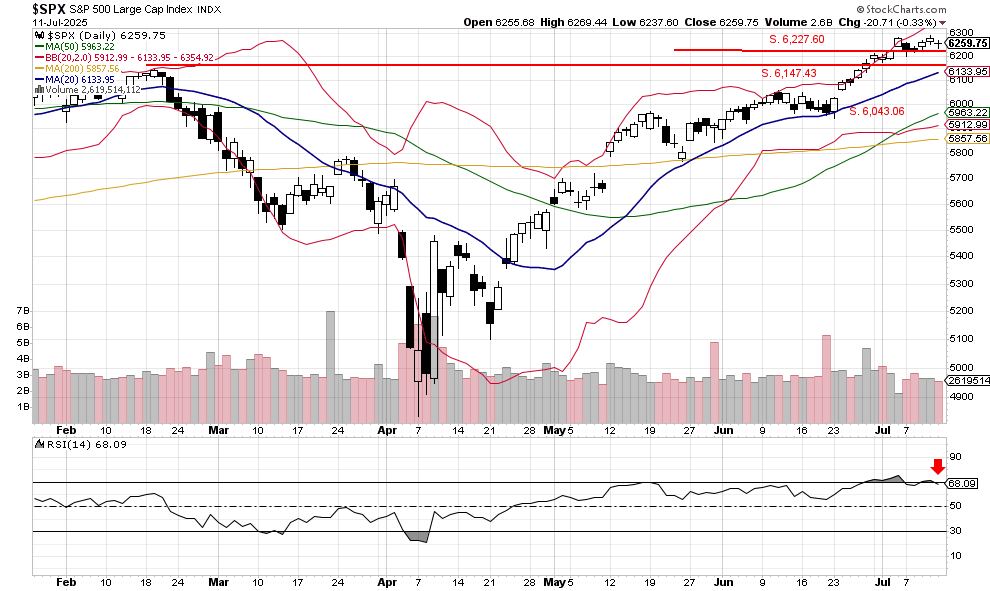Morning Brief

Headline News:
Equity futures are modestly lower this morning following the announcement of a 30% tariff on the EU and Mexico, effective August 1.
The head of the EU’s Executive Commission, Ursula von der Leyen, has stated that the EU will refrain from imposing any retaliatory measures until the August deadline in hopes of negotiating a better deal, according to Reuters.
Mexican President Claudia Sheinbaum has also expressed confidence that she can strike a more favorable deal before August, according to Bloomberg.
The stock market has been resilient in the face of tariff announcements over the past two weeks but has been subject to some softer pockets when the country in question is a close trading partner. Thursday saw the S&P 500 and Nasdaq Composite eclipse new all-time highs, but the market closed lower for the week following the announcement of a 35% tariff on Canada.
Though there are no economic data releases of note today, June CPI numbers will be released on Tuesday, and June PPI numbers come out on Wednesday, which could reflect the impacts of tariffs in relation to inflation.
(Michael Gibbs, Managing Director, Lead Portfolio Manager)
Markets:
The S&P 500 traded in a narrow range and closed nearly flat at 6,259.75, forming a five-day base between 6,277.60 and 6,290.22. Notably, the RSI dipped below the 70 threshold, potentially signaling weakness and opening the door for selling pressure. The key support at 6,277.60 has been tested multiple times and may be vulnerable today. If it breaks, the next major support lies at 6,147.43.
We are currently Intermediate-term bullish and short-term bullish.

John N. Lilly III CPFA
Accredited Portfolio Management Advisor℠
Accredited Asset Management Specialist℠
Portfolio Manager, RJFS
Partner, DJWMG
Windsor Wealth Planners & Strategists
Futures trading is speculative, leveraged, and involves substantial risks. Investing always involves risk, including the loss of principal, and futures trading could present additional risk based on underlying commodities investments.
The Relative Strength Index (RSI), developed by J. Welles Wilder, is a momentum oscillator that measures the speed and changes of price movements.
The percentage of stocks trading above a specific moving average is a breadth indicator that measures internal strength or weakness in the underlying index. The 50-day moving averages are used for short-to-medium-term timeframes, while the 150-day and 200-day moving averages are used for medium-to-long-term ones. Signals can be derived from overbought/oversold levels, crosses above/below 50%, and bullish/bearish divergences.
The Dow Jones Industrial Average (DJIA), commonly known as “The Dow,” is an index representing 30 stocks of companies maintained and reviewed by the editors of the Wall Street Journal. The Russell 2000 Index measures the performance of the 2,000 smallest companies in the Russell 3000 Index, which represents approximately 8% of the total market capitalization of the Russell 3000 Index.
The S&P 500 is an unmanaged index of 500 widely held stocks that is generally considered representative of the U.S. stock market. Past performance may not be indicative of future results. Keep in mind that individuals cannot invest directly in any index, and index performance does not include transaction costs or other fees, which will affect actual investment performance. Individual investors’ results will vary. Opinions expressed are those of the author, John N. Lilly III, and not necessarily those of Raymond James. “There is no guarantee that these statements, opinions, or forecast provided herein will prove to be correct. “The information contained was received from sources believed to be reliable, but accuracy is not guaranteed. Investing always involves risk, and you may incur a profit or loss. No investment strategy can guarantee success. The charts and/or tables presented herein are for illustrative purposes only and should not be considered as the sole basis for your investment decision. International investing involves special risks, including currency fluctuations, different financial accounting standards, and possible political and economic volatility. Investing in emerging markets can be riskier than investing in well-established foreign markets.
This is not a recommendation to buy or sell any company’s stock mentioned above.
US government bonds and treasury bills are guaranteed by the US government and, if held to maturity, offer a fixed rate of return and guaranteed principal value. US government bonds are issued and guaranteed due to the federal government’s timely principal and interest payment. Bond prices and yields are subject to change based on market conditions and availability. If bonds are sold prior to maturity, you may receive more or less than your initial investment. Holding bonds to term allows redemption at par value. There is an inverse relationship between interest rate movements and bond prices. Generally, when interest rates rise, bond prices fall, and when interest rates fall, bond prices generally rise.
The Nasdaq 100 (^NDX) is a stock market index made up of 103 equity securities issued by 100 of the largest non-financial companies listed on the NASDAQ. It is a modified capitalization-weighted index. It is based on exchange and not an index of U.S.-based companies.
The Russell 2000 Index is a stock market index that measures the performance of the 2,000 smaller companies included in the Russell 3000 Index. It is managed by London’s FTSE Russell Group and is widely regarded as a bellwether of the U.S. economy because it focuses on smaller companies that focus on the U.S. market.



